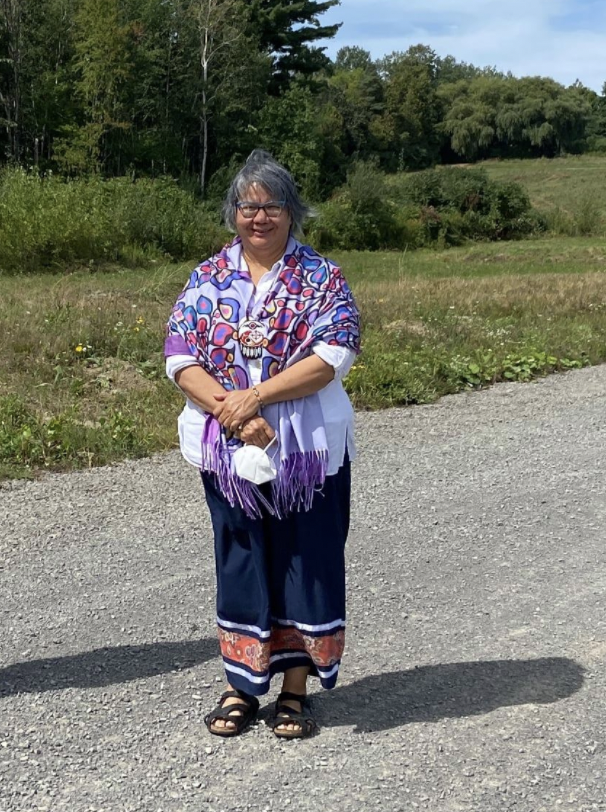Truth and Reconciliation Week: Orange Shirt Day – September 30
“The colour orange always reminded me how my feelings didn’t matter, how no one cared and how I felt like I was worth nothing. All of us little children were crying, and no one cared,” Phyllis Webstad
Phyllis Webstad is from the Stswecem’c (Canoe Creek) Xgat’tem (Dog Creek) First Nation. When she was six years old, she was sent to St. Joseph’s Mission Residential School in B.C. She wanted to look nice, so she chose to wear an orange shirt given to her by her grandmother. When she arrived at the school her orange shirt was taken from her, and she was forced to wear a uniform. This was just the beginning of the many things that were taken from her and all children who entered residential schools.
In 2013 Phyllis Webstad started Orange Shirt Day to remind people about the abuse and neglect that the children suffered. Wearing an Orange Shirt honours the children who did not come home and the survivors, their families and their communities.
Orange Shirt Day (Truth and Reconciliation Day) 2021 is now a federal holiday, with postal workers, federal government staff and bank employees getting the day off. The day is one of reflection on atrocities committed against Indigenous peoples. Only three provinces have designated the day as an official holiday. In provinces where it is not designated, it is up to employers whether to give the day off. In Quebec, September 30 is not a provincial holiday.
Orange Shirt Day is a symbol of the “stripping away of culture, freedom and self-esteem experienced by Indigenous children over generations.”
On this day:
- Wear an orange shirt purchased from an Indigenous company (Mi’kmaq Printing and design at www.mikmaqprinting.com).
- Read and reflect on the Truth and Reconciliation Commission Report 94 calls to action. Google: 94 Calls to Action
- Donate $30 to a local or national Indigenous organization working to improve the lives of children, families, individuals and communities.
- Watch online events hosted by the National Centre for Truth and Reconciliation.
- 48 books by Indigenous Writers to read to understand residential schools – article available online at CBC Books, June 10, 2021.
- Read Phyllis Webstad’s book, The Orange Shirt Story.

Truth and Reconciliation Week: Treaties and Unceded Territories
Treaties
Indigenous Peoples made treaties or agreements with each other long before the arrival of the settlers. These treaties helped to resolve conflicts and maintain good relationships between Indigenous groups. There is a long history of treaties between Indigenous people and the Crown(Government of Canada). There are 70 historic treaties and 24 Modern Treaties. This year is the 150th anniversary of Treaty 1 and Treaty 2 in Manitoba.
Indian Act
The Indian Act was created in 1876 and its goal was that the settlers would have control over all aspects of Indigenous culture. It forced a framework that excluded Indigenous people from owning property, voting and even prohibited Indigenous people from gathering in groups. The Indian Act forced children to attend residential schools.
Unceded Territory
There are vast areas of Canada that are not covered by treaties. This includes most of British Columbia, Newfoundland and Labrador, and Quebec. Indigenous Knowledge Keepers state firmly that treaties that were made were not “surrenders.” The Treaties represent an agreement to share the land and the goal is for all residents of Canada to live together in mutual harmony.
Land Claims
Despite the intention that treaties were not surrenders, a great deal of land was taken from First Nations people. Some of the land was sold and the government allowed construction on Indigenous land. Entire Native communities were relocated, and some homes were burned to prevent people from returning home.
Over the past few decades, Indigenous people have worked very hard to create new treaties or agreements. In some cases, compensation is sought to address the wrongs of the past.
“Land back isn’t just about the return of land, like physically… I want to be clear about that. It’s about First Nations being able to benefit from the land that the Creator placed us on. We have Creator-given rights. We were placed on these lands by the Creator, and we have sacred responsibilities to those lands and waters and animals and all the resources.
Land back is about making sure that First Nations are managing and upholding their responsibilities to the land and benefitting from the land, because that’s what treaties were about and are about: to have mutual benefit, to share the resources with the newcomers and settlers, to make sure that their lives would be filled with peace and friendship, which is what those first treaties were about as well.
So, the mechanism does exist. Of course, it does. But are governments willing to do that today? Maybe not. But we must start discussing it and moving toward it in some manner, because this is one of the great injustices in our shared history. First Nations have been placed here on Turtle Island, of which Canada is a part, and there’s such vast, enormous wealth that’s being taken from our lands and resources. Everybody can come to this country and build wealth and prosperity, but the people who have the God-given rights to this land. They are often living in conditions that are not equitable and not equal to everybody else. I think that’s a big part of what land back is about, as well as creating that sense of equality and equity and prosperity and making sure that First Nations benefit from their land,” RoseAnne Archibald, National Chief of the Assembly of First Nations, 2021.

